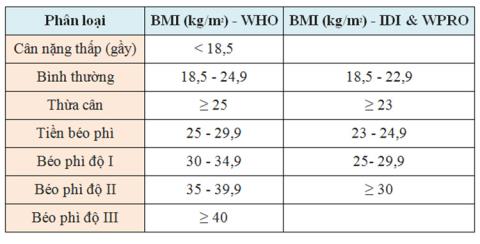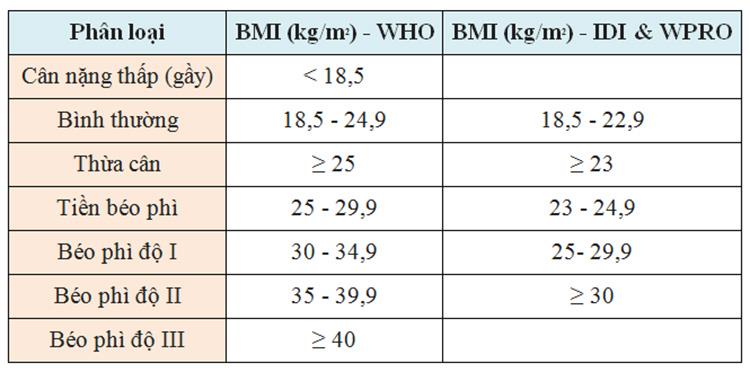Lets learn about grade 1 obesity

Obesity is now a common problem not only among children but also adults. But grade 1 obesity still accounts for the highest rate compared to other levels. Although this is only the beginning of obesity, the disease still has the risk of leaving many dangerous consequences. Let's learn more about this condition with the doctors SignsSymptomsList through the article below.
content
What is obesity?
Obesity is when more body fat accumulates than allowed. This phenomenon is the result of taking in more calories than you expend.
There are many causes of obesity . Usually, the disease is the result of many factors such as genetics, diet and exercise, or environmental influences.
According to doctors, obesity is the collective name for many levels of weight gain, starting with being overweight. Symptoms and treatment will vary depending on the stage of the disease. Therefore, you need to clearly determine your obesity status to have an appropriate weight loss plan.
Classification of obesity
The most common measure of body fat is the BMI. The formula for calculating BMI is to divide your weight by the square of your height. Based on the obesity classification for Asians, we will know exactly what our status is.

According to the Asian classification scale, obese people will have BMI from 25 to 29.9 .
However, this indicator does not usually apply to children. Because children are still developing, it is not possible to determine the degree of obesity in children based on BMI. Instead, parents should notice unusual signs in their children to promptly contact a doctor. Some of the observable signs are:
- Gaining weight too quickly.
- Round face, chubby cheeks, with fat lines in the neck, abdomen, thighs or groin, armpits.
- Sweat a lot while running.
What is grade 1 obesity?
Obesity is a concern of many developed countries. But in Asia in general and Vietnam in particular, grade 1 obesity is still the most common case. Based on the BMI classification, a person who is obese at level 1 will have a BMI ranging from 25 -29.9. At this point, you need to pay more attention to your weight and start changing your daily routine.
Signs of obesity grade 1
Normally, your body will give warning signals that your weight needs to be adjusted. Some of the symptoms may include:
- Waist measurement increased. According to the World Health Organization (WHO), when the waist-to-hip ratio is above 0.9 for men or 0.85 for women, you are at risk for grade 1 obesity .
- Poor eyesight.
- Frequently hungry.
- Or snore.
- Shortness of breath for a long time.
- Heartburn.
- Having skin problems such as stretch marks, dark skin and loose skin in the neck area.
- Varicose vein.
- Pain in joints such as knees, hips or back.
- Irregular menstruation.
- Body stagnation and fatigue.
If you have the above signs, you should plan to lose weight quickly to prevent obesity.

Waist/butt ratio is 0.85 for women, you are at risk of obesity grade 1
The harmful effects of obesity grade 1
Grade 1 obesity is the mildest of the obesity classifications. However, this condition can still cause many harmful effects of obesity if not treated promptly. Fat accumulation in the body is a risk factor for many diseases such as:
- Cardiovascular diseases: Excess fat often increases bad cholesterol. This is the main factor leading to atherosclerosis, high blood pressure, heart failure, etc.
- Increased blood sugar: Obesity has a negative effect on the body's response to insulin. According to doctors, obesity is the main risk factor for diabetes.
- Other diseases: gallstones, gastric reflux, fatty liver, etc.
- Causes some cancers such as rectal cancer, gallbladder cancer, etc.
How to treat grade 1 obesity
According to doctors, grade 1 obesity can be completely overcome by lifestyle changes. Since this is only the beginning of obesity, measures such as medication or surgery are not yet necessary.
Building a scientific diet
The most common cause of obesity is unhealthy eating habits. Busy life makes many people often choose processed foods with high calorie content. As a result, obesity rates are increasing, especially in developed countries.
To lose weight effectively, nutritionists offer the following menu building tips for obese people :
- Eat small meals to make it easier to control food intake.
- Practice the habit of eating slowly, chewing thoroughly, and limiting snacking.
- Choose foods that are high in fiber such as green vegetables and fruits.
- Eat whole grains like brown rice, cereals, corn, potatoes, etc.
- Stay away from foods that are high in sugar, high in fat or grease, alcohol, and carbonated soft drinks.
Increase movement
For an effective weight loss process, regular exercise is an indispensable factor. Doctors recommend that you exercise for 30-45 minutes/day and maintain at least 5 days/week. Obese people can freely choose exercises and intensity according to their ability. However, if you have other health problems, you need to consult with your doctor to find the right exercise.
For people with grade 1 obesity who don't have enough time, you just need to try to be active instead of just sitting around. Routine activities such as housework, going for a walk are good alternatives.

You should exercise regularly for 30 minutes/day and at least 5 days/week
Get enough sleep
Research shows that people who sleep less than 5 hours are 2.5 times more likely to be obese than the average person. When sleep deprived, the body produces hormones that stimulate appetite, especially sweets. In addition, getting enough sleep helps the metabolism to take place better. Therefore, you will easily control your weight.
Drink enough water
The lack of water is also one of the causes of obesity . Besides, water helps curb cravings and reduce bad cholesterol in the body. Therefore, water is the perfect assistant for obese people during weight loss. If possible, drink at least 2 liters of water a day.
Maintain a healthy lifestyle
Stress also contributes to more weight gain than usual. The reason is that when you are stressed, you tend to turn to sweets to help you feel better. This long-term condition will lead to obesity.
Grade 1 obesity is the beginning of obesity . For treatment, patients only need to follow a healthy diet, exercise, and exercise routine. You should not try to lose weight very quickly, but implement long-term weight loss methods to ensure safety for your health.